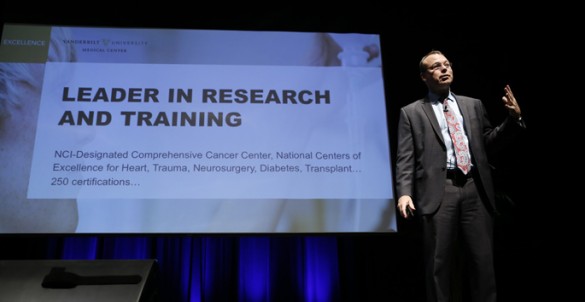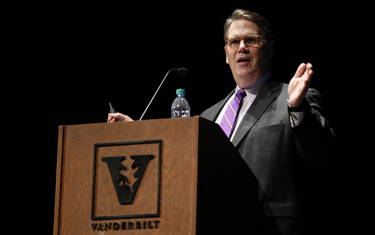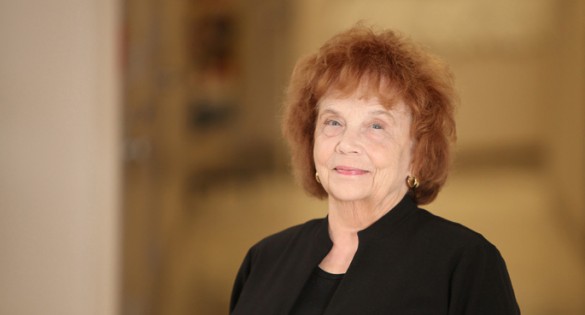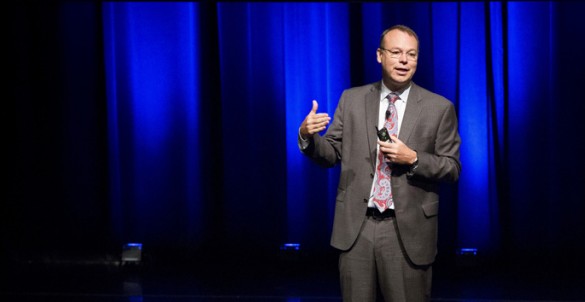
“Building an empowerment culture” was the theme of the Spring 2016 Clinical Enterprise Leadership Assembly at Vanderbilt University Medical Center (VUMC) for more than 900 staff and faculty leaders who attended the quarterly assembly at Langford Auditorium.
Luke Gregory, chief executive officer of Monroe Carell Jr. Children’s Hospital at Vanderbilt, opened the meeting by noting it was the first assembly after the restructuring that established the Medical Center as a separate, nonprofit entity apart from Vanderbilt University, adding, “We are now five days old.”
Jeff Balser, M.D., Ph.D., president and CEO of VUMC and dean of the School of Medicine, began his presentation by explaining that institutional investors who recently purchased bonds issued by VUMC, allowing the Medical Center to purchase buildings and other assets from Vanderbilt University, were highly responsive to the opportunity to invest in the Medical Center.
“Vanderbilt University Medical Center is more than 150 years old, so it felt a little bit strange to present us to investors as a new entity, but it turned out to be a validating experience to see how big investment companies like Vanguard and others would respond,” he said.
The fact that VUMC is a substantial entity with annual operating revenue of $3.3 billion and is the largest private employer of Tennessee residents impressed people, Balser said. VUMC is a large health system that includes four hospitals and clinics, as well as the expanding Vanderbilt Health Affiliated Network. Another strategic advantage Balser cited is that VUMC is now governed by an 11-member Board of Directors who are focused solely on the Medical Center’s needs.
The fact that Vanderbilt trains many of the doctors, nurses and allied health professionals who go on to work within the institution, or can be recruited by Vanderbilt Health Affiliated Network (VHAN) hospitals and physician practices, is also a major strength. Balser noted there are approximately 1,000 physicians-in-training in more than 130 programs at VUMC. As a result, VUMC trains 43 percent of pediatricians and 33 percent of general surgeons who go on to practice in Tennessee.

In addition, the Medical Center’s Nurse Residency Program is nationally competitive and results in cohorts of 100-200 new nursing school graduates arriving at VUMC two times each year to train, he said. Many of these new nurses stay on after the completion of their residency.
“We train many of our own folks, and that’s not typical for a health system,” Balser said. “In enormous numbers of medical specialties, and in many sub-specialties, we’re the only training center in the state.”
Another strength that impressed investors is VUMC’s continued commitment to innovation and research, and Balser pointed to Vanderbilt-Ingram Cancer Center, which is one of only 45 National Cancer Institute-designated Comprehensive Cancer Centers in the United States, as an example of that strength.
Balser devoted the remainder of his talk to what to expect moving forward. The Epic Leap project to fully implement the Medical Center’s new clinical, administrative and billing software, as well as the addition of four floors to Children’s Hospital, are both large initiatives that will require funding. At the same time, a key five-year financial goal will also be to further build VUMC’s savings, increasing the number of days of operating cash on hand.
Now that the Medical Center’s restructuring is complete, Balser said the next steps are to strategically grow the health system, make care more seamless through the EpicLeap project and empower leaders at all levels within the organization, which he explained includes everyone at VUMC.
“We all own VUMC. So empowering leadership can’t just be about the 900 of us sitting here. It has to be about all of 20,000 of us working here each day. We want everyone to feel that ownership,” he said.
C. Wright Pinson, MBA, M.D., deputy CEO and Chief Clinical Officer of VUMC and CEO of the Vanderbilt Health System, began his presentation by acknowledging the Medical Center’s recently earned accolades: Becker’s Hospital Review named VUMC as one of the 100 Great Hospitals in America; Forbes named VUMC one of America’s Best Employers; and The Leapfrog Group just awarded VUMC their ninth consecutive A rating in hospital safety.
He also said that VUMC has experienced recent growth in the opening of a new kidney transplant evaluation center in Huntsville, Alabama; the new Vanderbilt Bone & Joint Clinics in Franklin and Brentwood, Tennessee; and a seventh LifeFlight base will open this summer in Cookeville, Tennessee.
Pinson then reviewed progress on this year’s Pillar Goals. Performance toward goals in Quality, Service, especially access, Innovation and goals in Growth & Finance have been especially successful. Significant progress also has been made in the People pillar regarding employee engagement and retention, he said.
“Overall, we’re in great shape thanks to the aligned hard work and commitment of everyone in this room, as well as your teams,” Pinson said. “Considering the added duties associated with our transition with the University and a rigorous budget season, this performance is pretty remarkable.”
In quality measures, there has been a 15 percent reduction this year in health care-associated infections. For example, Children’s Hospital is approaching one year without a catheter-associated urinary tract infection, hospital-acquired conditions are down 25 percent and Observed-to-Expected Mortality performance has improved by more than 10 percent.
As part of the commitment to empowerment, Pinson said it is important for everyone to have a voice, and the VUMC Culture Survey will be conducted from May 16-29. All VUMC faculty and staff are asked to complete the survey, which will include questions related to employee engagement.
Pinson also shared four new priorities for fiscal year 2017.
These are:
• Workforce Engagement — Focusing on what energizes the workforce, and specifically building middle managers as the backbone of the organization.
• EpicLeap — Successfully transforming the clinical enterprise through workflow improvements, enhanced governance and better IT tools.
• Academic Integration — Through the Medical Center’s clinical, academic and research programs working together more closely than ever before.
• Strategic growth — Through the thoughtful approach regarding where to grow.
Pinson said a great example of strategic growth is what is taking place within the Vanderbilt Health Affiliated Network.
“The network has been steadily growing since the initial idea was presented in a Clinical Enterprise retreat in July 2011, and its official founding in December 2012,” he said. “What started as four founding hospitals in Middle Tennessee is now the largest provider-organized network of doctors, regional health systems and other health care providers in Tennessee and surrounding states.”
The Vanderbilt Health Affiliated Network includes 11 health systems from Memphis to Johnson City, with 48 hospitals and nearly 3,500 clinicians. This represents more than 230 practices serving more than 100,000 patients spilling into four states. VUMC leaders have been asked to help other organizations implement similar networks in their geographical areas, and Vanderbilt Health Affiliated Network will be introduced to the public in mid-May with an awareness campaign to explain what the network has to offer.
Finally, three VUMC leaders presented, in a talk show format, practical messages about how they successfully solved problems or used innovation to create solutions. This presentation of “VUMC Live,” led by Marilyn Dubree, M.S.N., R.N., Executive Chief Nursing Officer, demonstrated great examples of empowered leaders.
Paul Harris, Ph.D., M.S., professor of Biomedical Informatics and Engineering, spoke about the development of Redcap, the Web-based data management platform developed at VUMC and used worldwide to securely collect and manage translational and clinical research data.
Ali Grubbs, MSN, R.N., Nurse Manager, Neurosciences 6 North, described how her team made remarkable progress in lowering falls on her unit.
And Rod Armstrong, MSN, R.N., Nurse Manager, Pediatric Hematology/Oncology unit at Children’s Hospital, talked about his team’s successful efforts to lower C. Diff infections on its unit.















